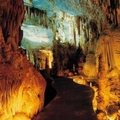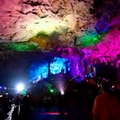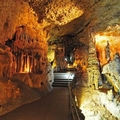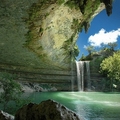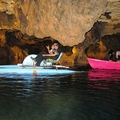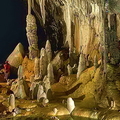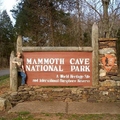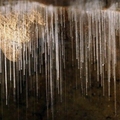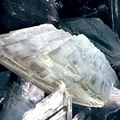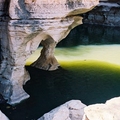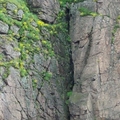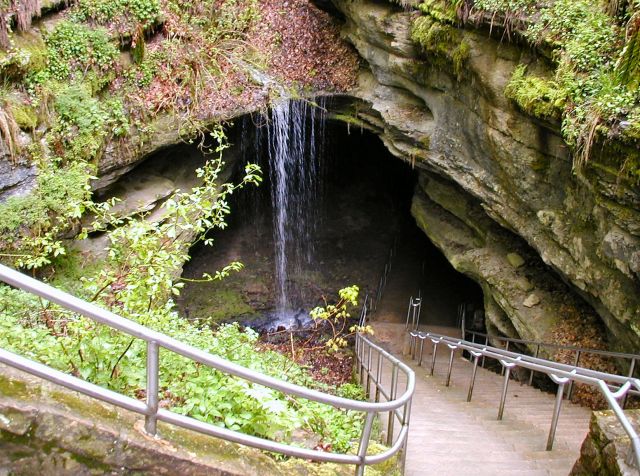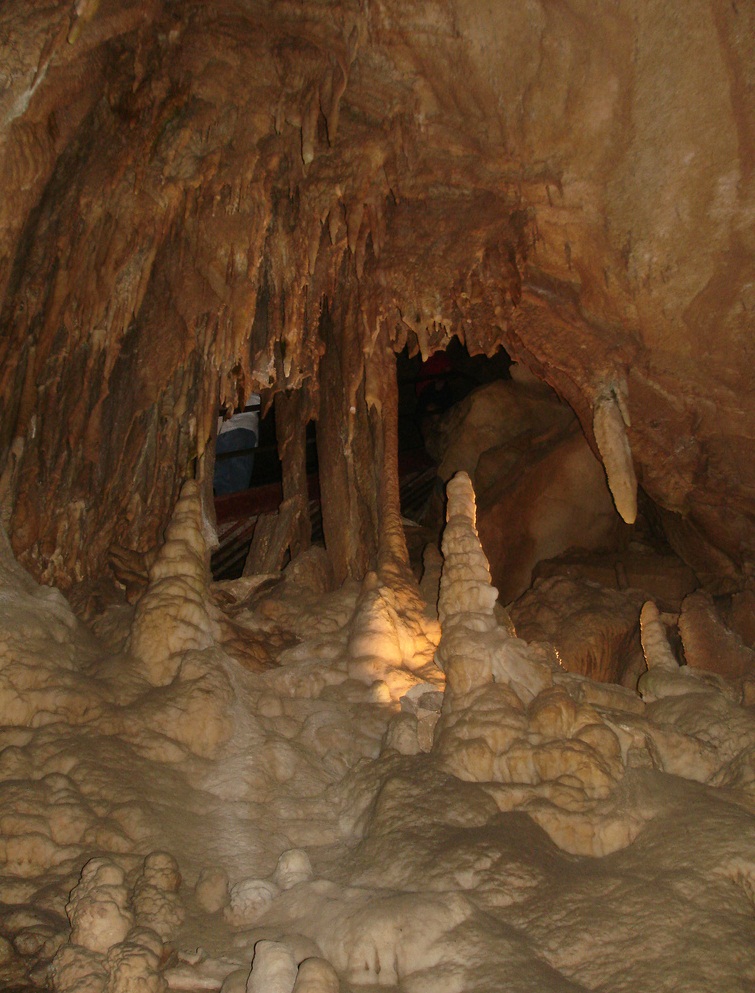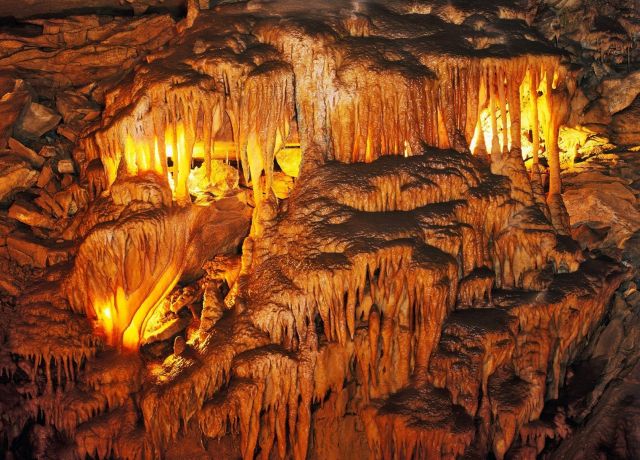Eco-friendly locations / The Most Beautiful Caves and Grottos of the World / Mammoth Cave National Park, U.S.A.
Mammoth Cave National Park, U.S.A.
The Mammoth Cave is the longest underground system of labyrinths in the world. The Mammoth Cave is a place of beauty, mystery and paradox. It is now the realm of underground lakes and canyons, waterfalls and streams, narrow passages covered with a dome of large halls. Located 80 km from the city of Bowling Green, Kentucky cave contains one of the world's largest underground tunnels, so that is included in the UNESCO World Heritage List. The mysterious sinkholes, the underground caves, waterfalls and the formation of gypsum karst attract numerous visitors. No one yet knows the true size of the Mammoth Cave. The new cave passages constantly open up the border of this spectacular underground labyrinth extending deeper and deeper into the depths of the underworld. The Mammoth Cave is the longest in the world of the underground labyrinth system, if the second and the third longest cave in the world combined, it still would have remain the longest in the world with a margin of 160 km!
Hystory
The history of the National Park entered due to the Mammoth Cave and has lived here since historic times. Anthropologists believe that the Native Americans first discovered it about 4000 years ago. Being used for lighting the torches from the bundles of the reeds it still continues to grow nearby. Ancient torches were found many miles inside the cave. Nearly 5 kilometers from the entrance a mummified body of a miner, who died about 2,000 years ago was found. His death crushed the huge five-ton boulder. The human body and his clothes are well preserved. When the first Europeans arrived in the Green River Valley in the early 1790s, Kentucky was still part of Virginia. The legend has it that the first European who discovered the Mammoth Cave was either John Hauchayn, or his brother Francis Hauchayn. In 1797, while hunting, Hauchayn was chased by a bear and found the entrance to the cave near the River Green. During the War of 1812, the cave served as an important source of nitrate, which was used mainly for the black population of America. The extraction of nitrate at that time was of great importance since it served as a key component for the manufacture of gunpowder. During the War of 1812 between the United States and Britain, a significant part of nitrate was necessary for the conduct of hostilities and it was produced in the Mammoth Cave. Its owners have relied on the work of 70 African slaves to mine this valuable mineral. After the war ended in 1815, the price of saltpeter plummeted and its production became unprofitable. However, people who learned about the cave began to visit it to see the huge size of this underground miracle with their own eyes. In subsequent decades, the cave became a popular tourist attraction. In 1839, the Mammoth Cave was purchased by Dr. John Krogan. Krogan bought and put in order the adjacent hotel for tourists. The former owner of the cave, Franklin Gorin, bought three young slaves: Stephen Bishop, brothers Matt and Nick Bransfordiv to work as tourist guides. Stephen Bishop was a talented researcher and guide. He made many discoveries that increased the popularity of the cave over the next decade. Stephen became the first man who crossed the "Abyss" (Bottomless Pit) - a big hole depth over 30 meters. Stephen Bishop was one of the most popular guides in the history of the Mammoth Cave, and his advice needed almost everyone who visited the cave. Many of his discoveries are described in the guidebook “Rambles in the Mammoth Cave”. Dr. Krogan was interested in the possible healing properties of the cave. He believed that the constant temperature and the humidity of the cave can be useful for the people suffering of tuberculosis. In the spring of 1842 he placed the patients of this disease in wood and stone houses built in the center of the cave. The visitors of that period were constantly. In 1843, the experiment ended in failure. Several patients have died, and other state has deteriorated. Obviously, the high humidity inside the cave and the low temperature only caused harm, not help to the people who were sick. Two stone houses are still preserved in the Mammoth Cave as a remembrance of this experiment. Ironically, Dr. Krogan himself died of a severe illness in 1849.
The Cave of Kentucky War
Difficulties in agriculture, the poor soils served the cause of the desire of the owners of small caves located near Mammoth, switched to farming activities on other types of businesses. Through the development of transport in the first quarter of the 20th century, rail and road significantly increased the number of visitors to the cave. In the mid-1920s the area around the Mammoth Cave became the center of what historians have called the "Cave of Kentucky War" - a period of intense competition between the owners of the local caves for the sake of making money from tourism. We used a widely practice of deception for the sake of luring tourists to other small caves. Along the roads leading to the Mammoth Cave, fake street signs had been installed, attracting tourists astray, and send them to other caves. The owners of these small caves were forced to think that they've Mammoth, although in reality it was a different cave. A typical strategy in the initial stages of nucleation automobile travel was the fact that the Capper (face, luring suckers), jumping on the bandwagon drive-by tourists, tried to persuade the passengers that the Mammoth Cave was closed, quarantined, collapsed in a word that was not available to the public and offered them to visit another cave.
Creating the National Park Mammoth Cave
After the death of Dr. Krogan, his nephews and nieces owned the cave on the rights of the trustees, until the last of the heirs died in 1926. According to his will, after the death of the last heir, the Mammoth Cave should be sold at public auction. With the death of the last heir of Dr. Krogan, of Kentucky, wealthy residents spread the movement for the establishment within the cave national park. The citizens of the state formed a social organization of the Association of National Park Mammoth Cave. They believed that the only way to ensure its protection for future generations was the creation of a national park. The Mammoth Cave was considered as a clear candidate for the status of the park and support from the state authorities. In fact, the establishment of the national park was difficult to achieve because, unlike areas such as parks, Yellowstone and Yosemite, the area around the Mammoth Cave was occupied by the farmers and the local entrepreneurs, many of whom did not want to leave their land, and opposed the creation of a national park. On May 25, 1926 the President Calvin Coolidge signed a bill creating the National Park Mammoth Cave. The law linked the creation of the park, depending on the donations of the land of the federal government. To purchase land some farmers used donations of wealthy citizens, while other land was purchased under a legitimate right of the state to alienate private property. In contrast to the formation of other national parks in the United States little populated areas of the country, thousands of people have been forcibly resettled in other places of residence. Like American Indians originally inhabited the land, the descendants of European settlers who arrived in the Green River Valley in the 1790s, also had to leave the area. The Mammoth National Cave Park was officially opened on July 1, 1941 in order to "protect the unique underground labyrinth, the hilly terrain from the top, and the Green Valley."
The Mammoth Cave: interesting facts
How has the cave formed? The ancient sea covered the central part of the contemporary United States, 325 million years ago, leaving more than 180 meters of soluble limestone, covered with a layer of sandstone later and shale deposits of an ancient river. The top layer covered the bottom like an umbrella. The river and the sea have disappeared, and the forces of erosion undermined this upper layer of about 10 million years ago, when cracks and holes uncovered limestone surface. Geologists believe that the old part of the Mammoth Cave began to form about 10 million years ago. Rainwater, oxidized carbon dioxide in the soil, seeped through the cracks and started to dissolve the limestone, creating a maze of passageways, amphitheaters, rooms and voids that we know under the name of the Mammoth Cave. Many internal features such as stalagmites, stalactites and columns, formed the rate of one cubic inch for every 100 to 200 years.
Why is it called the "Mammoth Cave"?
The name Mammoth was first used to describe the caves in the early 1800s. The name was used by the huge size of systems of labyrinths and passages, and has nothing to do with the mammoth. Any information about finding the remains of the mammoth is not true.
The length of the Mammoth Cave
To date, the researchers have mapped 584 km of passages that made the Mammoth Cave the longest cave system in the world. Researchers continue to discover new passages, and, as they say, "the end of the edge is not visible." Professional cavers continue to explore the cave system, making new cards and opening new passages, many of which are difficult passages.
Bats
Once the Mammoth Cave had a population of 12.9 million bats in the historical section alone. Although the bats continue to live in a cave, today their number does not exceed several thousand. Now environmentalists are working to restore the program population of bats.
Tourism and Attractions
The Mammoth Cave U.S. National Park Service offers visitors a number of rounds of the cave. Tours last from one to six hours. Two tours are conducted using only a paraffin lamp, and are a popular alternative electricity lit routes. A few "wild" tours depart from well established parts of the caves and tunnels leading into dust. The tours of the park are distinguished by quality outreach programs. Information for tourists depends on the tour, so taking a few tours, visitors learn about different aspects of the formation of the cave and its history. The six-hour tour is the most popular among tourists. The groups go through Cleveland Avenue, which is a long hall of cylindrical shape, carved by groundwater. Its walls are gleaming white gypsum, crystallized under a layer of limestone. Then the route goes through the Snowball Dining Room, where you can stay and eat. After this, the tour goes through the Boone Avenue - a deep gorge, whose width is so narrow that you can easily with both hands touch the opposite walls of the passage. The tour ends at the Frozen Niagara. Rich mineral water is seeping through the rock, gradually forming the Frozen Niagara, characterized by the presence of stalactites, stalagmites, stone images of waves on the walls, simulating the drop of water. One part of the Mammoth Cave is known as the Methodist Church, where it is believed were religious rites in the early 1800s. Visitors to this part of the cave are given the opportunity to experience that they feel the first tourists. The guide turns off the lights and light the torches, and the visitors personally see how the cave looked like before the installation of the electric lighting there. The Booth Amphitheatre is another famous place of the Mammoth Cave. It was visited by the actor Edwin Booth, the brother of Lincoln assassin John Wilks Booth. It is said that Edwin Booth was reading a monologue of Hamlet "To be or not to be" at this point. Nearby there is a deep hole in the ground, known as The Abyss (Bottomless Pit). It was named the first cave guides, unable to see it through the bottom of the faint light of oil lamps. Bottomless Pit depth is of 32 meters.
Log in Mammoth Cave.
One of the most famous and the most photographed sites in the park particularly useful when looking from the middle of the cave out. The most famous and popular former Green River tour, during which visitors were able to sail a boat on the underground river, was abolished in the early 1990s for environmental reasons. Furthermore, the content of the cave passages for the public display, periodically subjected to flooding were incredibly expensive. During the season, tourists were offered round the cave, which let you see the underground river. Visitors to the National Park rarely see more than 20 km of passages that are available for tours. If you have free time, you can explore a cave alone. Additionally, you can do hiking or riding horses more than 112 km2, located on the surface of the park, fishing and boating on the River Green. The peak tourist season in the park is in summer, when an average of 5,000 to 7,000 visitors daily visit the park. Annually about 500 000 tourists visit the cave.
Others from The Most Beautiful Caves and Grottos of the World
Do we know everything about this world? Of course not, and the most interesting thing is that we know a little about what is on the surface of this planet, but nothing is really aware of the fact of what is at the bottom, below the surface.
But underground there are many wonderful things, in particular, the caves, which keep their secrets from us humans.
I want to present to you, dear readers, the most interesting and the most beautiful caves of our world.
From childhood we are taught that there are caves with stalactites and stalagmites that have formed over centuries, millennia draining down water - drop by drop, and on the ceiling and the floor of the cave gradually formed tumors by mineral particles contained in water.
Caves are subterranean voids that were formed by leaching of soft rocks, tectonic processes, etc.
There is unique fauna in the caves, which members have developed other ways of feeling and movements due to the absence of light.
Each cave is a special world, where you can see its beauty.
Thus, the Onogonda Caves from Missouri and the Red Flute Cave of Canada are known for their stalactites and stalagmites.
The last was named so because the whole cave has excellent acoustic properties, and despite its length of 240 meters, the flute is perfectly audible from end to end.
There also are icy caves where there is plenty of both ice and fire.
The ceilings of some caves are completely covered with ice, and at the bottom some lava flows.
Such caves can be found in Vietnam, Scotland and Norway, respectively.
Cavity: the real meaning of peace Cavities are formed by water, which create enormous empty spaces below the surface, washing out the breed for millennia.
Few countries can boast such caves, the cave Deer, known as the longest mall in the world.
A closer example, the Hugden Grotto, known for its waterfalls and in Slovenia Skocjan equally beautiful and frightening.
Man slightly ennobled them, sheds and bridges were conducted under ground electricity, but it further emphasizes the wild nature of these caves.
Morokkan cave in North Africa is probably the most unusual and beautiful cave in the world.
The thing is that in the vault of this cave is a hole, through which the sun looks periodically.
People took it as marked by God for a long time because what else enters the cave beside the sun? Caves are places of mystery, paradox and beauty.
Find out which are the most amazing and famous caves and grottos in the world created by nature.

